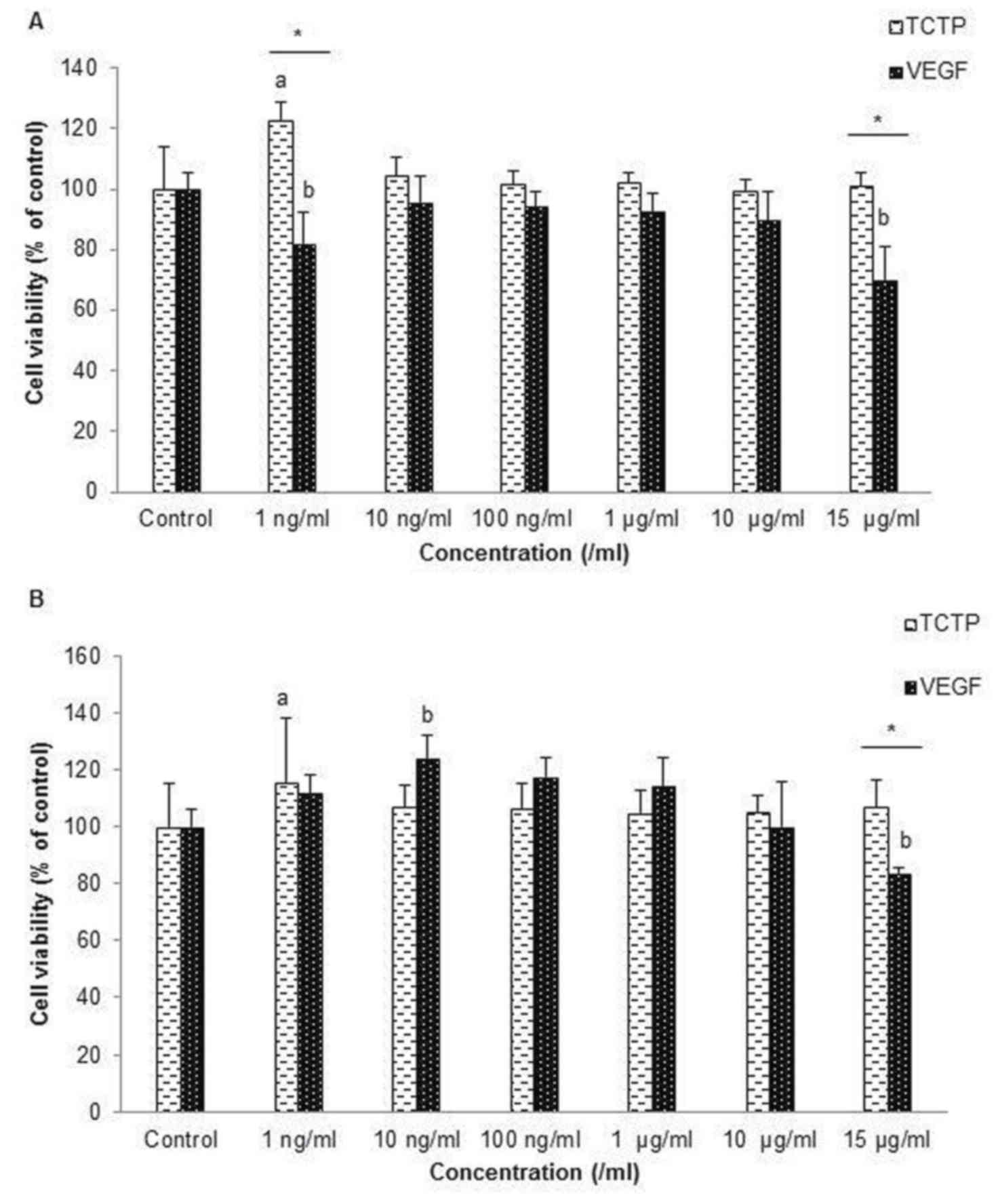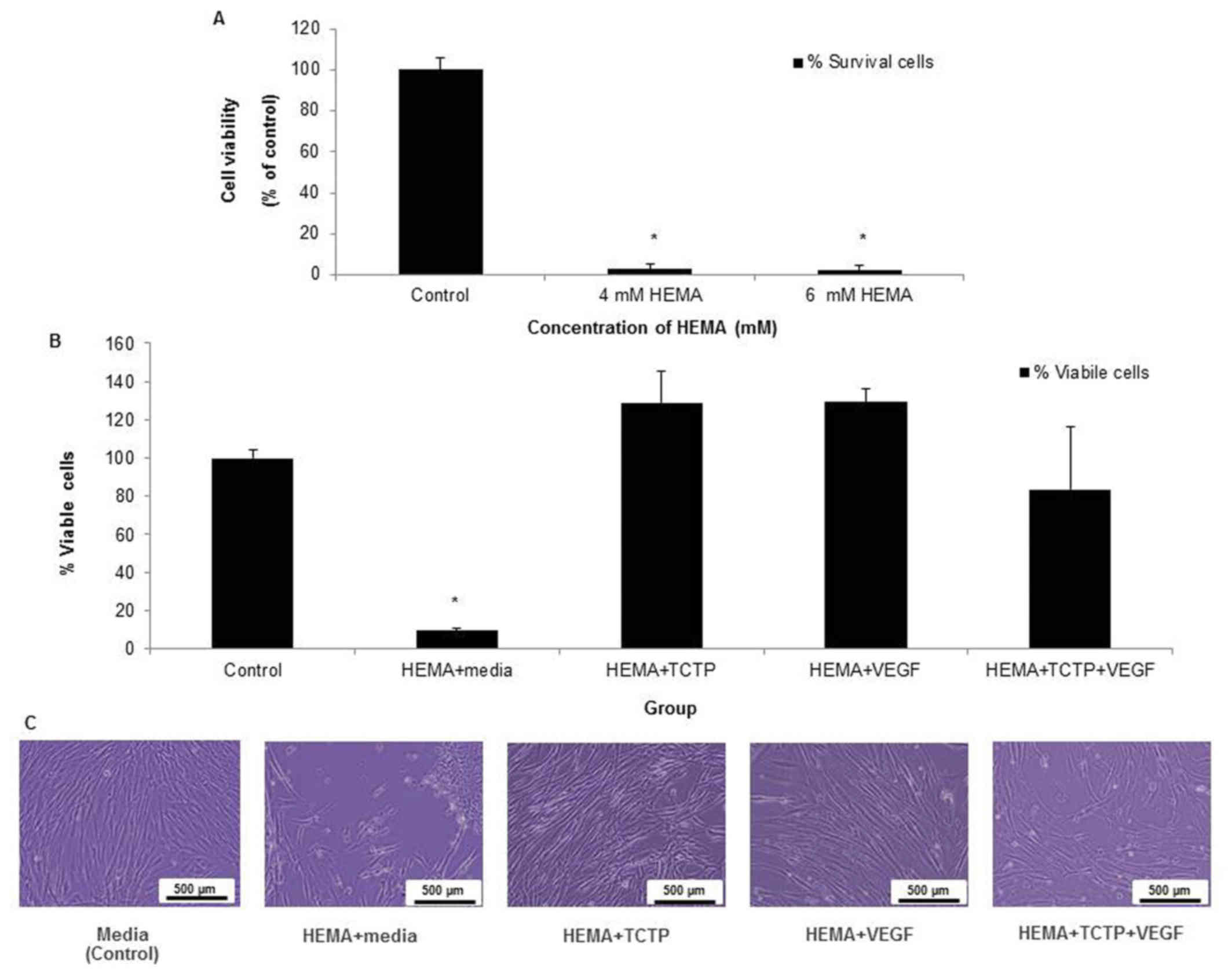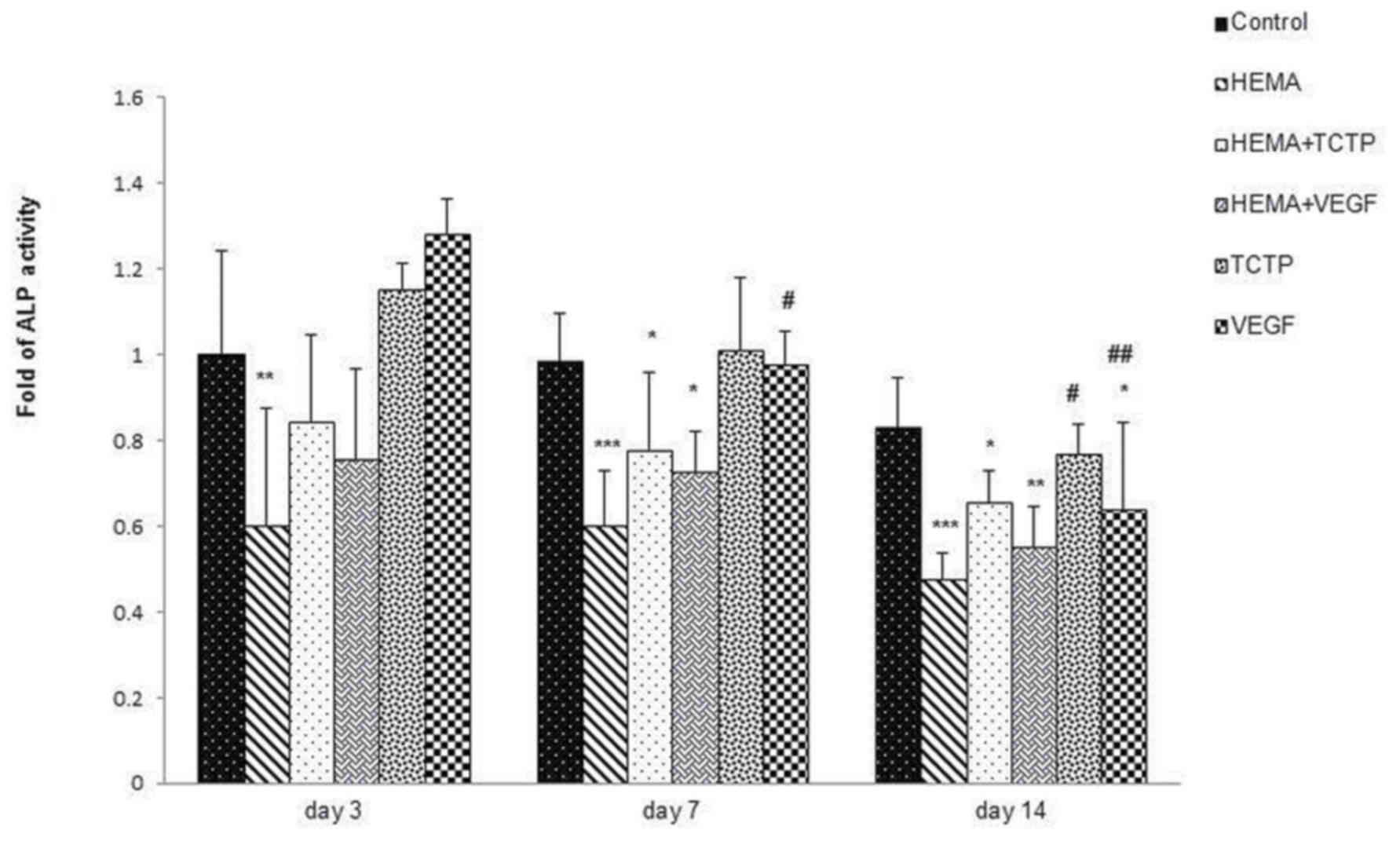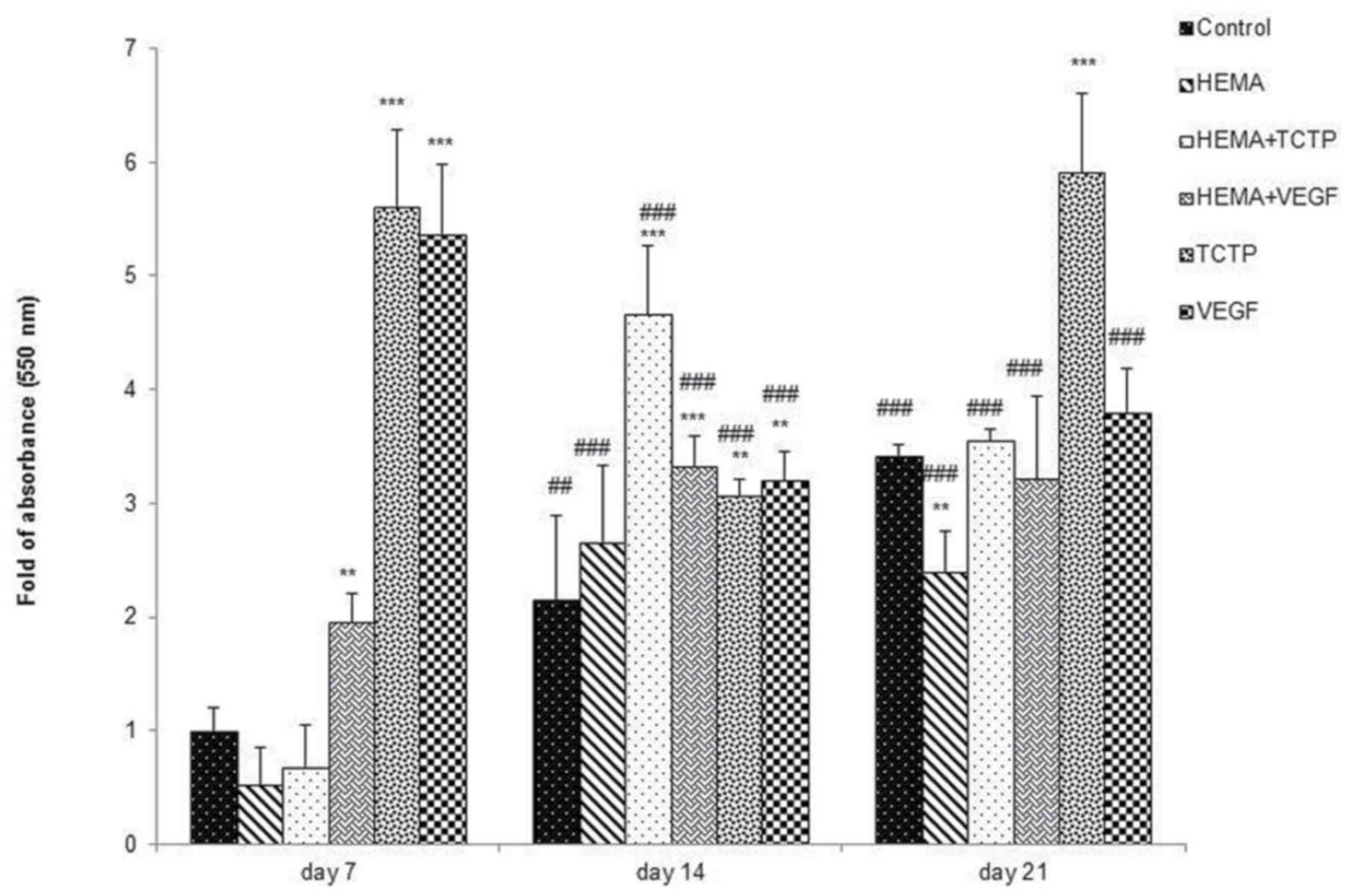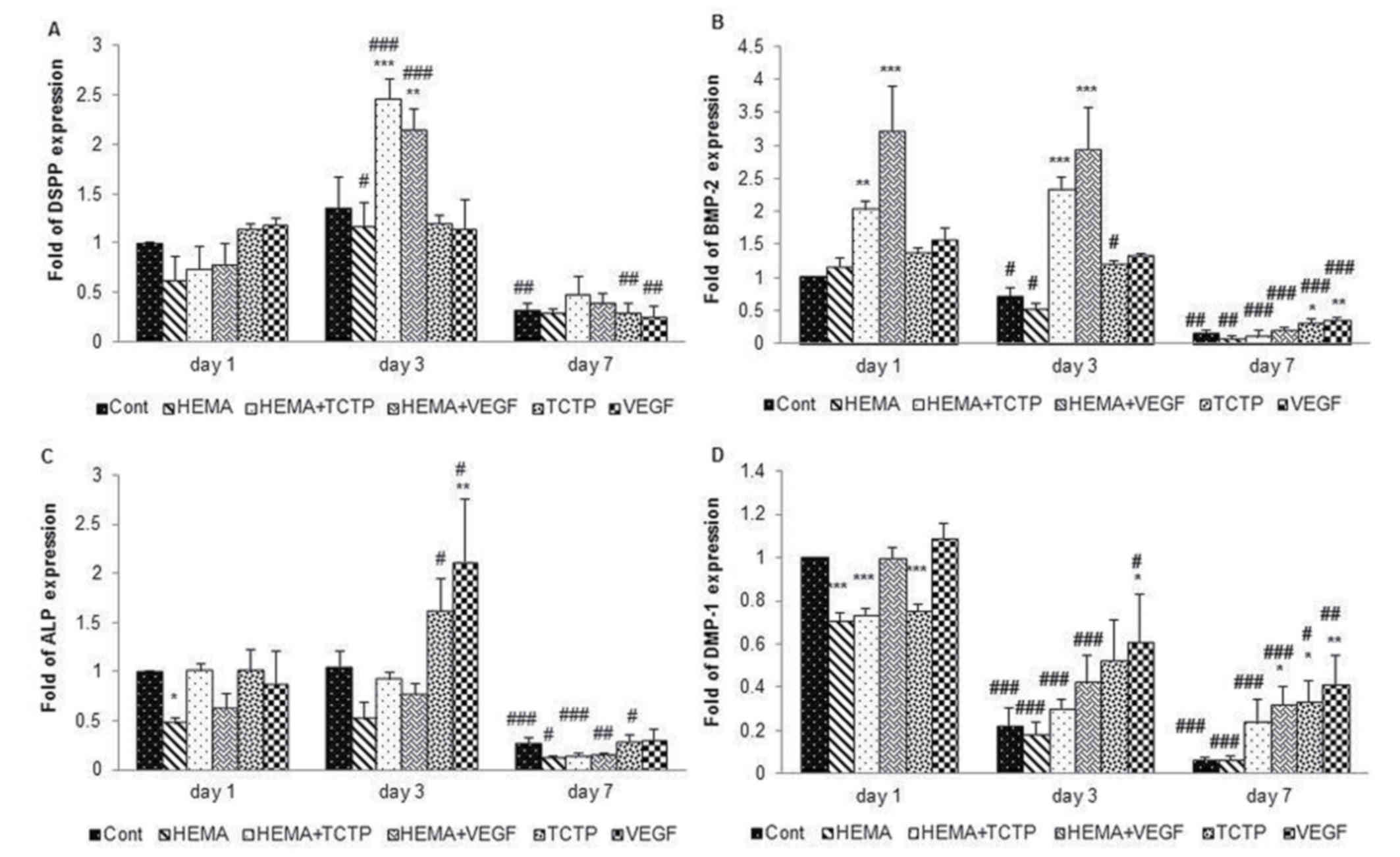Effect of recombinant vascular endothelial growth factor and translationally controlled tumor protein on 2‑hydroxyethyl methacrylate‑treated pulp cells
- Authors:
- Published online on: February 12, 2018 https://doi.org/10.3892/mmr.2018.8593
- Pages: 6100-6108
Abstract
Introduction
Growth factor typically acts as signaling molecules between cells and is an important component required for tissue engineering. There have been many attempts at developing dental biomaterial or scaffold supplemented with a single or combination of active molecules to induce dentine or pulp regeneration. One growth factor that was widely selected for this purpose is vascular endothelial growth factor (VEGF).
VEGF-A is one of the four subtypes of VEGF (-A, -B, -C, and -D) that are expressed in dental pulp with autocrine and paracrine effects in blood vessels and immune cells (1). It is a potential signaling protein that can promote angiogenesis and activate dentin regeneration (2). VEGF has been used in growth factor delivery-based tissue engineering (3), including pulp tissue regeneration for regenerative endodontics (4). Moreover, VEGF has been shown to induce proliferation and differentiation of human pulp cells into odontoblasts (5). Another interesting property of VEGF is helping cells survive from stress or hazardous conditions. There have been some studies reporting that VEGF played a role in survival of serum-starved endothelial cells (6,7), as well as survival of these cells in hypoxic conditions (8). A previous study has also revealed that VEGF expression was upregulated in mouse odontoblast-like cells (MDPC-23) exposed to 2-hydroxyethyl methacrylate (HEMA) (9).
HEMA is a major monomer released from incomplete polymerization of resin-based dental restorative materials. It is cytotoxic to cells and can damage DNA (10), leading to proliferation impairment (11) and delayed cell differentiation (12).
Translationally controlled tumor protein (TCTP) is a conserved protein found in many eukaryotic cells ranging from plant to animal kingdoms (13). TCTP has many functions, including proliferation, maturation, and antiapoptosis (14). TCTP from Penaeus merguiensis (Pmer-TCTP) has been shown to have an antiapoptotic property against HEMA-treated dental pulp cells (15). A new formula of resin modified glass ionomer cement supplemented with TCTP can reduce cell death from residual HEMA release (16). The aim of this study was to compare cell proliferation, anticytotoxicity, differentiation and mineralization of VEGF-A with TCTP on HEMA-treated human dental pulp cells (HDPCs). This will assist the further development of a restorative material that may have less toxicity and be able to regenerate pulpal dentine complex.
Materials and methods
Expression and purification of recombinant TCTP and recombinant VEGF
Expression of Pmer-TCTP gene was performed in the bacteria Escherichia coli (E. coli) strain BL21. The protein was purified according to methods previously described (14). Briefly, E. coli strain BL21 harboring pGEX-Pmer-TCTP was inoculated and induced by 1 mM IPTG (isopropyl β-D-thiogalactopyronositol) for stimulating protein expression. After induction for 3 h, the bacterial cells were harvested by centrifugation and the soluble glutathione S-transferase (GST)-TCTP protein was purified by using Glutathione Sepharose 4 Fast Flow (GE Healthcare Bio-Science, Piscataway, NJ, USA) and thrombin was used for splitting of GST-tagged protein. The purified Pmer-TCTP protein with molecular mass about 19.2 kDa (168 amino acid residues) was determined by SDS-PAGE and protein concentration was analyzed by a BCA protein assay kit (Pierce; Thermo Fisher Scientific, Inc., Waltham, MA, USA). Recombinant human VEGF was purchased from Gibco® (Gibco; Thermo Fisher Scientific, Inc.). This protein has about 40 kDa (homodimer) with 165 amino acid residues/subunit.
Cell culture
HDPCs were cultured from pulp tissue of sound third molar teeth of adults aged 18–25 years at the Dental Hospital, Faculty of Dentistry, Prince of Songkla University, with consent forms approved by the Research Ethics Committee (Number EC5703-09-P-LR), Faculty of Dentistry, Prince of Songkla University. Primary culture of pulp cells was performed using an enzymatic method. Briefly, the pulp tissue was cut into small pieces before digested in 3 mg/ml of collagenase type I and 4 mg/ml of dispase for 1 h at 37°C. After centrifugation, cells were cultured in α-MEM, supplemented with 10% fetal calf serum (FCS), 100 µM L-ascorbic acid 2-phosphate, 100 µM L-glutamate, 100 U/ml penicillin, and 100 µg/ml streptomycin and incubated at 37°C with 5% CO2. Pulp cell passages between three and five were used for this study.
Finding effective concentrations of TCTP and VEGF on HDPCs
The effect of TCTP and VEGF at various concentrations on HDPCs was examined by the 3-(4, 5-dimethylthiazol-2-yl)-2,5-diphenyltetrazolium bromide (MTT) assay. TCTP and VEGF were diluted with cell culture medium at various concentrations varying from 1 ng/ml to 15 µg/ml (n=5 in each group). HDPCs at a density of 5×103 cells/well were cultured in 96-well plates in a humidified atmosphere of 5% CO2 at 37°C for 24 h and then the culture medium supplemented with TCTP and VEGF were replaced. After 24 and 72 h, the medium was removed, 200 µl of fresh medium containing 10 mM HEPES (pH 7.4) and 50 µl MTT solution (5 mg/ml in PBS) were added to each well and incubated in the dark for 4 h at 37°C. The medium and MTT were then removed and 200 µl of DMSO and 25 µl of Sorensen's glycine buffer (0.1 M glycine plus 0.1 M NaCl equilibrated to pH 10.5 with 0.1 M NaOH) were added. The optical density (OD) of formazan production was measured at 570 nm. The OD values adjusted for a blank (medium only) of the experimental groups were divided by the control (cell cultured in normal medium without TCTP and VEGF) and expressed as percentages of the control, which represented the percentages of viable cells.
Cytotoxicity of HEMA
MTT assay was used to evaluate the cytotoxicity of HEMA at two concentrations, which were 4 mM and 6 mM. HDPCs were seeded at 8×103 cells/well in a 96-well plate at a humidified atmosphere of 5% CO2 at 37°C. After 24 h, the media was replaced with HEMA mixed in culture medium and left for 24 h. Then the media was refreshed with normal media and incubated for 48 h before MTT assay was performed as described previously (n=5 in each group).
The results from HEMA cytotoxicity testing led to the selection of 4 mM HEMA as a cytotoxic reagent. In addition, the result from effective concentrations of TCTP and VEGF suggested the use of TCTP at 1 and 10 ng/ml of VEGF for further investigation.
The recovery effect of TCTP and VEGF on HEMA-treated HDPCs
There were five groups of HDPCs according to different medium conditions: HEMA, HEMA+TCTP, HEMA+VEGF, HEMA+TCTP+VEGF, and control group (culture medium only). HDPCs were seeded at 8×103 cells/well on a 96-well plate at a humidified atmosphere of 5% CO2 at 37°C and fed with normal medium. After 24 h, the culture medium was replaced with media supplemented with substances as described above for 24 h. After that, the fresh media was replaced and incubated for 48 h. The viable cells were determined by the MTT assay (n=5 in each group).
Alkaline phosphatase (ALP) activity assay
ALP activity assay was used to determine odontoblast-like differentiation. The experiment was divided to six groups according to substances added to the medium: HEMA, HEMA+TCTP, HEMA+VEGF, TCTP, VEGF and cells cultured in normal medium as a control group. HDPCs were seeded at 1×104 cells/well on a 24-well plate and fed with normal culture medium using 15% FCS at a humidified atmosphere of 5% CO2 at 37°C (n=3 in each group). The medium was changed every 2 days and the ALP activity of cells was determined after being cultured for 3, 7 and 14 days. The ALP activity was measured by using p-nitrophenol phosphate as a substrate. Cells were washed twice with PBS pH 7.4 and lysed in 20 µl/well of lysis buffer (100 mM MgCl2·6H2O, 1 M Tris-HCl pH 7.4, 0.1% Triton-X 100, pH 10) on ice and centrifuged at 14,000 g at 4°C for 10 min. The supernatant was collected for total protein and ALP activity determinations. The total protein was determined by using BCA kit. For ALP activity assay, 5 µl of the supernatant of each sample was incubated in 50 µl of ALP substrate solution containing 0.2 M 2-amino-2-methyl-1-propanol (AMP), 4 mM MgCl2 and 50 µl of 4 mg/ml p-nitrophenol phosphate at 37°C for 30 min. Then, the reaction was stopped with 100 µl of 0.1 M NaOH. The absorbance was measured at 405 nm. ALP activity was calculated as nanomolar of p-nitrophenol per µg of total protein and adjusted to the increased percentage compared to the control (medium only).
Alizarin red S (ARS) staining assay
Alizarin red S (ARS) staining assay was used to evaluate calcium deposition. There were six groups according to different substances added in the inductive medium, which were HEMA, HEMA+TCTP, HEMA+VEGF, TCTP, VEGF and the last group was cells cultured in an inductive medium only as a positive control group. HDPCs at 1.5×105 cells/well were seeded on a 12-well plate and fed with 500 µl/well of inductive medium, which was composed of 1 M β-glycerophosphate, 10 mg/ml ascorbic acid, 100 U/ml penicillin, 100 mg/ml streptomycin and 100 mg/ml antibiotic-antimycotic, in α-MEM with 20% fetal calf serum (n=3 in each group) at 37°C in a humidified atmosphere containing 5% CO2. After the first 24 h, the medium was refreshed and then the medium was replaced every 2 days. After 7, 14 and 21 days, the medium was removed and cells were washed with PBS pH 7.4 and fixed in 10% (v/v) formaldehyde (Sigma-Aldrich; Merck KGaA, Darmstadt, Germany) at room temperature for 15 min and washed twice with 1 ml/well of ultrapure water at room temperature for 5 min. Then Alizarin Red solution was added 1 ml/well and incubated on shaker for 30 min. After removal of ARS, the plate was washed four times with ultrapure water, while shaking for 5 min, and then Store plates at −20°C prior to dye extraction. The monolayers were incubated by 200 µl cetylpyridinium chloride (CPC) buffer for 2 h on a shaker. After that, it was centrifuged at 20,000 g for 15 min and 100 µl of the supernatant was then transferred to a 1.5 ml tube. It was diluted (10 µl of sample and 90 µl of CPC) to a 96-well plate and the OD values corrected for a blank (CPC only). The absorbance of the sample was measured in an ELISA reader at 550 nm.
Gene expression
Quantitative real-time reverse transcription polymerase chain reaction (qRT-PCR) was used to investigate the effect of each sample on pulp cells differentiation. Dentin sialophosphoprotein (DSPP), dentin matrix protein 1 (DMP-1), ALP and bone morphogenetic protein-2 (BMP-2) expressions were examined and gene glyceraldehyde-3-phosphate dehydrogenase (GAPDH) was selected to be an internal control. The primers (5′- and 3′-) were designed and shown in Table I. There were six groups in the experiment: HEMA 4 mM alone and with (1 ng/ml TCTP, 10 ng/ml VEGF) with pulp cells, 1 ng/ml TCTP, 10 ng/ml VEGF with pulp cells and cells cultured in normal medium was set as the control. The experiments were repeated three times. HDPCs at 1.5×106 cells were seeded on six-well plate with 2,000 µl/well of normal medium. After 24 h, the mixed-medium with selected supplements was replaced and then changed every 2 days. After 1, 3 and 7 days the medium was removed and cells were washed with PBS pH 7.4. The total RNA of cells was extracted and purified by RNeasy® Plus Micro kits (Qiagen, Inc., Valencia, CA, USA) and converted to cDNA with SuperScript™ III RT (Invitrogen; Thermo Fisher Scientific). The thermal profile for RT-PCR, under denaturing conditions was 65°C for 5 min followed by cDNA synthesis at 50°C for 30 min. The reaction was terminated at 85°C for 5 min. Then the remaining RNA was removed by adding 1 µl of RNase H at 37°C for 20 min and 3 µl of each cDNA product was fractionated by 1.2% agarose gel electrophoresis and visualized by ethidium bromide staining by ultraviolet (UV) transillumination. SYBR Green PCR master mix (Roche Diagnostics GmbH, Mannheim, Germany) was used for qPCR analysis. The qPCR mix consisted of 1 µl of cDNA, 2 µl of forward and reverse primer, 10 µl of SYBR Green and 5 µl of nuclease-free water, and the negative control was distilled water instead of cDNA sample. The reaction was performed manually in triplicates in each sample, at a final volume of 20 µl. The thermal profile for amplification of the investigated gene was followed by 40 cycles of denaturation at 95°C for 15 sec, annealing at 60°C for 30 sec and then elongation at 72°C for 30 sec. After the end of the last cycle, the final quantification was reported as an amount after normalization to reference gene GAPDH. Relative values were analyzed using comparative cycle threshold (CT) method (∆∆CT method).
Statistical analysis
The results of MTT were analyzed using the one way analysis of variance (ANOVA) and Tukey's post hoc-test to investigate the differences among the experimental groups. Unpaired t-test was used to compare the difference of means between two groups of TCTP and VEGF. Kruskal-Wallis and Dunnett multiple comparison were used to analyze the results of ALP assay, ARS assay and qRT-PCR. P<0.05 was considered as statistically significant.
Results
Effective concentration of TCTP and VEGF on HDPCs
HDPCs were treated with various concentrations from 1 to 15 µg/ml of TCTP and VEGF in order to find the effective concentrations that are not cytotoxic to cells and can also promote cell growth. After culturing for 24 h, most of the various concentrations of TCTP can promote cell growth because the percentage of viable cells was over 100% compared to the control (Fig. 1A), especially at 1 ng/ml of TCTP, which gave the highest percentages of cell viability (P<0.05). Cells cultured in medium supplemented with VEGF did not have a higher percentage of viable cells than the control after culturing for 24 h. However, after 72 h, it was found that at low concentration, especially at 1 ng/ml of TCTP and 10 ng/ml of VEGF, had significantly higher cell viability than the control and compared within groups (P<0.05). High concentration of VEGF at 15 µg/ml significantly reduced cell viability (Fig. 1B). The results led to the determination to use 1 ng/ml of TCTP and 10 ng/ml of VEGF in culture medium for further studies.
The recovery effect of TCTP and VEGF on HEMA-treated HDPCs
HEMA-treated pulp cells at concentration of 4 mM and 6 mM demonstrated its high level of cytotoxicity, because the percentages of viable cells were all less than 10% (Fig. 2A). The result from Fig. 2B showed that HDPCs cultured in 4 mM of HEMA with either 1 ng/ml TCTP or 10 ng/ml VEGF and both of combinations TCTP and VEGF had percentages of cell viability that were not statistically different from the control group, while cell viability in HEMA-treated cells was significantly lower than other groups (P<0.05) (Fig. 2B). The morphological features of HDPCs were shown in Fig. 2C. The results suggested that TCTP and VEGF had an ability to recover the viability of HEMA-treated pulp cells. It was noted that HEMA-treated cells supplemented with TCTP+ VEGF did not increase the percentages of cell viability, when compared to either TCTP or VEGF.
ALP activity
The result of ALP activity was revealed in Fig. 3. HEMA significantly reduced ALP activity compared to the control and TCTP or VEGF groups in all three periods (day 3 P<0.01), (day 7 and day 14 P<0.001). HEMA+TCTP and HEMA+VEGF groups had slightly higher ALP activity than HEMA within each time period.
Mineralization effect of TCTP and VEGF on HEMA-treated HDPCs
The Alizarin red S (ARS) assay was used to determine calcium deposition and the results have been shown in Fig. 4. After culture for 7 days, the levels of calcium deposition in TCTP and VEGF groups were higher than the others (P<0.001). However, calcium in group HEMA+VEGF was significantly higher than HEMA+TCTP and HEMA alone (P<0.01). In addition, after culture for 14 days, cells in groups HEMA+TCTP, HEMA+VEGF, TCTP, and VEGF had increased calcium deposition compared to the control. In particular, the HEMA+TCTP group had the highest calcium deposition (P<0.001). At this period, the level of calcium deposition in cells treated with TCTP and VEGF was reduced from 7 days. After culture for 21 days, HDPCs cultured in an inductive medium with added TCTP had increased calcium deposition and became the highest compared to other groups.
It was noted that HDPCs cultured in inductive medium only (control) had increased calcium deposition by time and reached its highest after 21 days. Cells treated with HEMA+TCTP had reached its highest calcium deposition after 14 days and then reduced, but were still the same level as control after 21 days. Furthermore, the groups of HEMA+TCTP and HEMA+VEGF had higher calcium deposition than the HEMA group at all three time periods.
Differentiation-related gene expression of HDPCs by qRT-PCR
The result of qRT-PCR was shown in Fig. 5. The response of DSPP gene was reported as an average of fold expression (Fig. 5A). At day 1, the expression of DSPP gene in cells treated with HEMA was lower than control, while upregulation was found in cells treated with TCTP and VEGF. At day 3, cells treated with HEMA+TCTP (P<0.001) and HEMA+VEGF (P<0.01) had significantly higher upregulation than other groups. However, downregulation was found in all groups on day 7.
The high level of BMP-2 gene expression was observed in cells treated with HEMA+TCTP on day 1 (P<0.01) and on day 3 (P<0.001) and HEMA+VEGF on day 1 and day 3 (P<0.001) (Fig. 5B). In addition, the expression of BMP-2 gene upregulated significantly highest in group HEMA+VEGF on day 1 and day 3 (P<0.001). BMP-2 gene was down regulated in all groups on day 7.
On day 1, the expression of ALP gene, in control group, HEMA+TCTP and TCTP was higher than other groups (Fig. 5C). Moreover, the upregulation of ALP expression in TCTP and VEGF groups increased immediately on day 3, and ALP expression in VEGF groups was significantly higher (P<0.01) compared to others which corresponded with the result of ALP activity in Fig. 3. ALP gene expression down regulated in all groups on day 7.
DMP-1 expression was reduced by time in all groups (Fig. 5D). DMP-1 expression in the control group, HEMA+VEGF and VEGF, were higher than other groups on day 1. The expression of DMP-1 gene upregulated significantly highest in VEGF group on day 3 (P<0.05). HDPCs treated with HEMA+VEGF (P<0.05), TCTP (P<0.05), and VEGF (P<0.01) were significantly higher compared to others on day 7.
Discussion
This study evaluated some biological properties of VEGF-A or VEGF, especially the anticytotoxicity, differentiation and mineralization in pulp cells compared to TCTP. Previous studies have reported that VEGF (3,5) and Pmer-TCTP (15) can promote pulp cell proliferation and differentiation, which were confirmed by the results of this study. The VEGF used in this study is in a homodimer form, which has 165 amino acid residues per monomer. Pmer-TCTP is composed of 168 amino acid residues and the molecular mass is not much different from this VEGF monomer. The effective concentration of VEGF that can promote cell growth after 72 h and also used to promote survival of HEMA-treated HDPCs was 10 ng, which was the working concentration that induced stem cells to differentiate (3). The concentration that promoted growth of HDPCs of TCTP was lower (1 ng/ml) than VEGF (10 ng/ml), which may suggest that TCTP has a higher potential than VEGF in promoting HDPCs growth.
Both TCTP and VEGF can survive HEMA-treated pulp cells. But they did not have a synergistic effect, as pulp cells treated with HEMA+TCTP+VEGF did not increase the percentages of viable cells compared to HDPCs exposed to either HEMA+TCTP or HEMA+VEGF. This result may suggest that the mechanism whereby both VEGF and TCTP survive HEMA-treated pulp cells might relate to each other or share the same carrier or pathway. However, further investigation is required.
The mechanism of the added VEGF that can promote HDPCs proliferation and survive cells from HEMA exposure may involve signal transduction through receptor tyrosine kinases, vascular endothelial growth factor receptor 2 (VEGF-R2), and lead to cell proliferation by either activation of the mitogen-activated protein kinases or MAPK cascade via Raf stimulation or PLC (phospholipase C)-γ. Activation of PI3K (phosphatidylinositol 3-kinase) leads to activation of PKB (protein kinase B) and the cell survival process (7,17). VEGF can also survive cells from hypoxic conditions via the PI3K/Akt/FoxO1 pathway (8). VEGF induces expression of the anti-apoptotic proteins Bcl-2 in vascular endothelial cells (18) and in leukemic cells (19).
TCTP and its anti-apoptotic effect against HEMA-treated pulp cells has previously been reported (15). The mechanism whereby TCTP can survive HEMA-treated pulp cells remains unknown. It was shown that TCTP can inhibit apoptosis by maintaining mitochondria stability and inhibiting Bax function (20), as well as forming heterocomplexes with Bcl-xL (21). However, TCTP also inhibits apoptosis by stabilizing anti-apoptotic Bcl-2 family proteins, MCL1 and by inhibiting p53-dependent apoptosis by down regulating this protein (14).
The results of ALP activity assay and cell mineralization by the ARS assay confirmed the results of other studies, which showed that TCTP (16) and VEGF (2) can enhance differentiation and mineralization of pulp cells. This was also consistent with qRT-PCR results that both TCTP and VEGF had up regulated ALP expression on day 3 compared to the control. TCTP may promote cell mineralization longer than VEGF, as shown in the results of calcium deposition after 21 days. DMP-1 is a phosphoprotein that activates both bone and dentin mineralization by inducing the deposition of mineral particles along the collagen fibrils (22). HDPCs had lower expression of DMP-1 in longer culture time in all groups, but it was noticed that TCTP and VEGF groups still had higher expression than the control after culture for 3 and 7 days, respectively.
This study revealed that HEMA at low concentration (4 mM) was cytotoxic to cells and caused down regulation of DSPP, BMP-2, ALP and DMP-1 expression. TCTP and VEGF up regulated DSPP expression on day 1 and BMP-2 expression on day 1 and day 3, which supports that both proteins can promote pulp cells differentiation, especially in TCTP/VEGF supplemented in HEMA-treated pulp cells. A recent study revealed that VEGF may have synergist effect to BMPs, including on cell survival and mineralization (23). Further investigation may be required concerning the potential connection of the two mechanisms protecting cell death and differentiation, since both VEGF and TCTP had anticytotoxicity and promoted cell differentiation.
In conclusion both TCTP and VEGF promoted pulp cells proliferation and survived HEMA-treated cells, but TCTP was required a lower concentration for these functions. They did not have a synergistic effect; however both of them can enhance cell differentiation and mineralization.
Acknowledgements
The authors would like to thank Professor Peter Leggat (James Cook University, Australia) for his advice and proof reading of the manuscript.
Funding
This study was supported by the Higher Education Research Promotion and National Research University Project of Thailand (grant no. DEN580513S), Office of the Higher Education Commission and a Postgraduate Grant, Prince of Songkla University.
Availability of data and material
The datasets generated and analyzed during the current study are not currently publicly available due to work in progress on a suitable repository in Thailand, however they are available from the corresponding author on reasonable request.
Authors' contributions
The current study was conceived by UK. CW performed the experiments, analyzed and interpreted the data in conjunction with WC and UK. CW and UK were the major contributors in writing the draft manuscript. All authors read and approved the final manuscript.
Ethics approval and consent to participate
The study was approved by the Human Research Ethics Committee, Faculty of Dentistry, Prince of Songkla University (approval number EC5703-09-P-LR) and by the Dental Hospital, Faculty of Dentistry, Prince of Songkla University. This included the use of approved consent forms for the collection of specimens.
Consent for publication
Not applicable.
Competing interests
The authors declare that they have no competing interests.
References
|
Virtej A, Løes S, Iden O, Bletsa A and Berggreen E: Vascular endothelial growth factors signalling in normal human dental pulp: A study of gene and protein expression. Eur J Oral Sci. 121:92–100. 2013. View Article : Google Scholar : PubMed/NCBI | |
|
Zhang J, Liu X, Yu W, Zhang Y, Shi C, Ni S, Liu Q, Li X, Sun Y, Zheng C and Sun H: Effects of human vascular endothelial growth factor on reparative dentin formation. Mol Med Rep. 13:705–712. 2016. View Article : Google Scholar : PubMed/NCBI | |
|
Yadlapati M, Biguetti C, Cavalla F, Nieves F, Bessey C, Bohluli P, Garlet GP, Letra A, Fakhouri WD and Silva RM: Characterization of a vascular endothelial growth factor-loaded bioresorbable delivery system for pulp regeneration. J Endod. 43:77–83. 2017. View Article : Google Scholar : PubMed/NCBI | |
|
Li X, Ma C, Xie X, Sun H and Liu X: Pulp regeneration in a full-length human tooth root using a hierarchical nanofibrous microsphere system. Acta Biomater. 35:57–67. 2016. View Article : Google Scholar : PubMed/NCBI | |
|
Matsushita K, Motani R, Sakuta T, Yamaguchi N, Koga T, Matsuo K, Nagaoka S, Abeyama K, Maruyama I and Torii M: The role of vascular endothelial growth factor in human dental pulp cells: Induction of chemotaxis, proliferation and differentiation and activation of the AP-1-dependent signaling pathway. J Dental Res. 79:1596–1603. 2000. View Article : Google Scholar | |
|
Gerber HP, McMurtrey A, Kowalski J, Yan M, Keyt BA, Dixit V and Ferrara N: Vascular endothelial growth factor regulates endothelial cell survival through the phosphatidylinositol 3′-kinase/Akt signal transduction pathway. Requirement for Flk-1/KDR activation. J Biol Chem. 273:30336–30343. 1998. View Article : Google Scholar : PubMed/NCBI | |
|
Latham AM, Odell AF, Mughal NA, Issitt T, Ulyatt C, Walker JH, Homer-Vanniasinkam S and Ponnambalam S: A biphasic endothelial stress-survival mechanism regulates the cellular response to vascular endothelial growth factor A. Exp Cell Res. 318:2297–2311. 2012. View Article : Google Scholar : PubMed/NCBI | |
|
Zhong Q, Zhou Y, Ye W, Cai T, Zhang X and Deng DY: Hypoxia-inducible factor 1-alpha-AA-modified bone marrow stem cells protect PC12 cells from hypoxia-induced apoptosis, partially through VEGF/PI3K/Akt/FoxO1 pathway. Stem Cells Dev. 21:2703–2717. 2012. View Article : Google Scholar : PubMed/NCBI | |
|
Mantellini MG, Botero T, Yaman P, Dennison JB, Hanks CT and Nor JE: Adhesive resin and the hydrophilic monomer HEMA induce VEGF expression on dental pulp cells and macrophages. Dent Mater. 22:434–440. 2006. View Article : Google Scholar : PubMed/NCBI | |
|
Ginzkey C, Zinnitsch S, Steussloff G, Koehler C, Hackenberg S, Hagen R, Kleinsasser NH and Froelich K: Assessment of HEMA and TEGDMA induced DNA damage by multiple genotoxicological endpoints in human lymphocytes. Dent Mater. 31:865–876. 2015. View Article : Google Scholar : PubMed/NCBI | |
|
Di Nisio C, D'Aurora M, di Giacomo V, Stuppia L, Cataldi A and Gatta V: Transcriptome modifications in human gingival fibroblasts exposed to 2-hydroxyethyl methacrylate. Gene. 582:38–46. 2016. View Article : Google Scholar : PubMed/NCBI | |
|
Kwon JH, Park HC, Zhu T and Yang HC: Inhibition of odontogenic differentiation of human dental pulp cells by dental resin monomers. Biomater Res. 19:82015. View Article : Google Scholar : PubMed/NCBI | |
|
Amson R, Pece S, Marine JC, Di Fiore PP and Telerman A: TPT1/TCTP-regulated pathways in phenotypic reprogramming. Trends Cell Biol. 23:37–46. 2013. View Article : Google Scholar : PubMed/NCBI | |
|
Nagano-Ito M and Ichikawa S: Biological effects of Mammalian translationally controlled tumor protein (TCTP) on cell death, proliferation and tumorigenesis. Biochem Res Int. 2012:2049602012. View Article : Google Scholar : PubMed/NCBI | |
|
Wanachottrakul N, Chotigeat W and Kedjarune-Leggat U: Translationally controlled tumor protein against apoptosis from 2-hydroxy-ethyl methacrylate in human dental pulp cells. J Mater Sci Mater Med. 22:1479–1487. 2011. View Article : Google Scholar : PubMed/NCBI | |
|
Wanachottrakul N, Chotigeat W and Kedjarune-Leggat U: Effect of novel chitosan-fluoroaluminosilicate resin modified glass ionomer cement supplemented with translationally controlled tumor protein on pulp cells. J Mater Sci Mater Med. 25:1077–1085. 2014. View Article : Google Scholar : PubMed/NCBI | |
|
Grando Mattuella L, Westphalen Bento L, de Figueiredo JA, Nor JE, de Araujo FB and Fossati AC: Vascular endothelial growth factor and its relationship with the dental pulp. J Endod. 33:524–530. 2007. View Article : Google Scholar : PubMed/NCBI | |
|
Gerber HP, Dixit V and Ferrara N: Vascular endothelial growth factor induces expression of the antiapoptotic proteins Bcl-2 and A1 in vascular endothelial cells. J Biol Chem. 273:13313–13316. 1998. View Article : Google Scholar : PubMed/NCBI | |
|
Dias S, Shmelkov SV, Lam G and Rafii S: VEGF(165) promotes survival of leukemic cells by Hsp90-mediated induction of Bcl-2 expression and apoptosis inhibition. Blood. 99:2532–2540. 2002. View Article : Google Scholar : PubMed/NCBI | |
|
Susini L, Besse S, Duflaut D, Lespagnol A, Beekman C, Fiucci G, Atkinson AR, Busso D, Poussin P, Marine JC, et al: TCTP protects from apoptotic cell death by antagonizing bax function. Cell Death Different. 15:1211–1220. 2008. View Article : Google Scholar | |
|
Thebault S, Agez M, Chi X, Stojko J, Cura V, Telerman SB, Maillet L, Gautier F, Billas-Massobrio I, Birck C, et al: TCTP contains a BH3-like domain, which instead of inhibiting, activates Bcl-xL. Sci Rep. 6:197252016. View Article : Google Scholar : PubMed/NCBI | |
|
Suzuki S, Haruyama N, Nishimura F and Kulkarni AB: Dentin sialophosphoprotein and dentin matrix protein-1: Two highly phosphorylated proteins in mineralized tissues. Arch Oral Biol. 57:1165–1175. 2012. View Article : Google Scholar : PubMed/NCBI | |
|
Li B, Wang H, Qiu G, Su X and Wu Z: Synergistic effects of vascular endothelial growth factor on bone morphogenetic proteins induced bone formation in vivo: Influencing factors and future research directions. Biomed Res Int. 2016:28695722016. View Article : Google Scholar : PubMed/NCBI |



